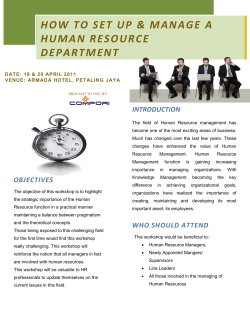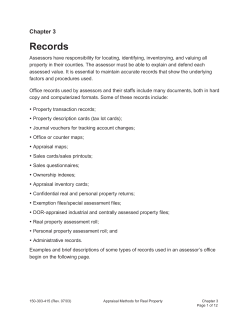
Project Cycle Management and Statistics Module 5
Project Cycle Management and Statistics Module 5 1 Who is this course for? This module aims to provide an understanding of how to better use statistics in planning, implementation, monitoring and evaluation in local government development planning and execution. 2 What will this course cover? Concepts, practices and use of statistics in: Overview of Project Cycle Management Identification of projects Project design Project appraisal Project implementation Monitoring and evaluation 3 Learning objectives (module) Explain the basic concepts of project planning and management Equiping participants with project identification skills Training participants on how to prepare/design projects for funding and implementation Explain the use of statistics in project cycle management Train participants on how to implement and manage projects Orient participants into the world of project monitoring and evaluation 4 Prerequisites Completion of Modules 1 to 4 of this course. 5 Duration and timetable 6 hours for 6 days (12 sessions) Day 1: Basic Concepts Day 2: Project Identification Day 3: Project Design Day 4: Project Appraisal & Implementation Day 5: Monitoring and Evaluation Day 6: Review 6 Resources Training course materials that have been prepared for the course. The 2004 NSDS Annex Tables District Development Plans District sector reports (District Statistical Abstracts) 7 Discussion Discuss as a class (for about 15 mins): What you hope to get out of this Module Why you have come on it What you feel you have to offer this Module Whether you feel the learning objectives are feasible 8 Module 5: Session 2 The Basic Concepts of Project Cycle Management 9 Overview The session covers the concepts used in all stages of project cycle starting with the identification of objectives, then design and proceeding to the implementation, and includes monitoring and evaluation of development projects . 10 Learning objectives (session) By the end of this session, participants should be able to; Explain the basic concepts of project planning and management Describe project cycle management, its elements and relationships 11 Activity (45 mins) Introduce the session to the participants Brainstorming to list basic concepts used in project cycle management. Write down the meaning of the different concepts used in project planning and management 12 What is a project? The difinition of the term project should include the following terms/words Planned undertaking Set of interrelated and coordinated activities Budget Time Specific objectives 13 What is a project? … A project may be defined as a set of activities, which aim at achieving specific objectives within a stipulated period of time and budget. 14 The Project Cycle A continuous process made up of separate and complementary stages (phases) each with its own characteristics and each setting a ground for the next one. 15 The project cycle Identification Design Evaluation Appraisal Implementation Monitoring 16 Project Cycle Management The process of planning and managing projects, programmes and organizations Involves a set of planning tools that feed into the logical framework All aspects of the project cycle are considered to ensure that any changes are included in the project design 17 What is a log Frame? An overview of a project or programme plan A tool used to help strengthen project design, implementation and evaluation A table of 4 rows and 4 columns defining objectives, outputs, indicators, means of verification, risks and assumptions 18 The Log Frame 19 What shows that a project has begun ? When somebody conceives the idea When a Government official makes a statement about it. When data is collected about the area/community needs/problems. When one identifies a problem 20 Stages/ Phases of the Project Cycle Idea conception and project identification Project write up/formulation/preparation/ design Project presentation, appraisal, selection, negotiation, approval Project implementation and management Project monitoring and supervision Project evaluation 21 What is Project Identification? Involves needs assessment - collecting, processing and analyzing data on problems/needs of communities The data/ information provides a basis for the next or second stage of the project cycle. 22 Project Identification …. Review of secondary data Look at books, survey reports/ research papers, publications, media reports, internet e.t.c. Are the facts accurate? Are the facts supported by evidenece? Is the information up-to-date? Example: the 2004 NSDS report, the 2002 census report, the district statistical abstracts 23 Project Identification … Collecting and analyzing primary information Interviews Community mapping Focus Group Discussions Other methods 24 Project Preparation / Design Involves analyzing the information from the identification stage in detail to formulate a project document. Stakeholders Analysis Research Problem Analysis Log Frameworks The economic, financial, social, ecological are analysed and the results documented. These dimensions are summarized into a project write up or proposal. 25 Project Appraisal This is the assessment or in depth analysis or examination of all the aspects of the project technical, financial, community participation, socio-economic benefits, organization and management, environmental impact, political risks, project sustainability and replicability. 26 Project Implementation This stage involves transforming the project proposal into the actual project or reality. Putting into practice the plans that had earlier on been appraised following the already laid down time table or work plan. It leads to the realization of project outputs and immediate objectives. 27 Project Monitoring It is a continuous assessment or review and surveillance by the project management at every level of the hierarchy of the implementation of the project It is aimed at tracking the progress of the project by ensuring that input and material deliveries, work schedules, targeted outputs and other required actions are proceeding according to plan. It is “Keeping track of events in relation to work plan and targets. 28 Basis for Monitoring Periodic reports Regular project management and staff meetings Observations Field visits and inspection. 29 Project Evaluation This is a process of determining systematically and objectively the relevance, efficiency, effectiveness and impact of the project in light of its objectives. The comprehensive review, assessment and critical analysis not only of the project results, but also the initial assumptions underlying the project elements including the relevance of the problem statement. 30 Module 5: Session 3 Overview of Statistics in Project Cycle Management 31 What does the Session Cover? The Session covers: An overview of the use of statistics in each of the phases of the project cycle Learning Objectives (Session) Explain the use of statistics in project cycle management 32 Relevance of statistics to planning What data is needed to: Prepare a plan or project? Appraise a plan or project? Implement a plan or project? Monitoring a plan or project? Evaluate a plan or project? Data and statistics are required!! 33 Use of Statistics in project cycle management Statistics/ data is used in the different stages. In this session we shall consider: Project Identification Project Design Project Implementation 34
© Copyright 2025





















